Exploring Sintered Fe-(Ce, Nd)-B with High Degree of Cerium Substitution as Potential Gap Magnet
Abstract
1. Introduction
2. Materials and Methods
2.1. Magnet Compositions
2.2. Magnet Synthesis
2.3. Magnet Analysis
3. Results
3.1. Magnetic Properties
3.2. Microstructure
3.2.1. Phase Identification
3.2.2. Quantitative Analysis of Phase Content
3.2.3. Quantitative Analysis of Grain Size and Degree of Texture
3.2.4. Chemical Composition and Local Distribution of RE-Elements
4. Discussion
4.1. Correlation between Microstructure and Magnetic Properties
4.2. Comparison with Other Sintered and Rapidly Quenched Magnets of Similar Ce Content in the Literature and with Commercial Magnets
4.3. Potential as Gap Magnets
4.4. Further Investigations
5. Conclusions
Author Contributions
Funding
Institutional Review Board Statement
Informed Consent Statement
Data Availability Statement
Acknowledgments
Conflicts of Interest
References
- Keller, T.; Baker, I. Manganese-based permanent magnet materials. Prog. Mater. Sci. 2022, 124, 100872. [Google Scholar] [CrossRef]
- Cui, J.; Kramer, M.; Zhou, L.; Liu, F.; Gabay, A.; Hadjipanayis, G.; Balasubramanian, B.; Sellmyer, D. Current progress and future challenges in rare-earth-free permanent magnets. Acta Mater. 2018, 158, 118–137. [Google Scholar] [CrossRef]
- Mandal, S.; Debata, M.; Sengupta, P.; Basu, S. L10 FeNi: A promising material for next generation permanent magnets. Crit. Rev. Solid State Mater. Sci. 2023, 48, 703–725. [Google Scholar] [CrossRef]
- Woodgate, C.D.; Patrick, C.E.; Lewis, L.H.; Staunton, J.B. Revisiting Néel 60 years on: The magnetic anisotropy of L10 FeNi (tetrataenite). J. Appl. Phys. 2023, 134, 163905. [Google Scholar] [CrossRef]
- Ochirkhuyag, T.; Tuvshin, D.; Tsevelmaa, T.; Hong, S.C.; Odbadrakh, K.; Odkhuu, D. Fe-Ni based alloys as rare-earth free gap permanent magnets. Acta Mater. 2024, 268, 119755. [Google Scholar] [CrossRef]
- Wang, J.P. Environment-friendly bulk Fe16N2 permanent magnet: Review and prospective. J. Magn. Magn. Mater. 2020, 497, 165962. [Google Scholar] [CrossRef]
- Hirayama, Y.; Takahashi, Y.K.; Hirosawa, S.; Hono, K. NdFe12Nx hard-magnetic compound with high magnetization and anisotropy field. Scr. Mater. 2015, 95, 70–72. [Google Scholar] [CrossRef]
- Schönhöbel, A.M.; Madugundo, R.; Gabay, A.M.; Barandiarán, J.M.; Hadjipanayis, G.C. The Sm-Fe-V based 1:12 bulk magnets. J. Alloys Compds. 2019, 791, 1122–1127. [Google Scholar] [CrossRef]
- Tozman, P.; Sepehri-Amin, H.; Hono, K. Prospects for the development of SmFe12-based permanent magnets with a ThMn12-type phase. Scripta Mater. 2021, 194, 113686. [Google Scholar] [CrossRef]
- Williams, H.J.; Bozorth, R.M.; Shockley, W. Magnetic Domain Patterns on Single Crystals of Silicon Iron. Phys. Rev. 1949, 75, 155. [Google Scholar] [CrossRef]
- Skomski, R.; Coey, J.M.D. Magnetic anisotropy—How much is enough for a permanent magnet? Scr. Mater. 2016, 112, 3–8. [Google Scholar] [CrossRef]
- Nguyen, V.v.; Nguyen, T.X. Effects of microstructures on the performance of rare-earth-free MnBi magnetic materials and magnets. Phys. B Condens. Matter 2018, 532, 103–107. [Google Scholar] [CrossRef]
- Ohtani, T.; Kato, N.; Kojima, S.; Kojima, K.; Sakamoto, Y.; Konno, I.; Tsukahara, M.; Kubo, T. Magnetic properties of Mn-Al-C permanent magnet alloys. IEEE Trans. Magn. 1977, 13, 1328–1330. [Google Scholar] [CrossRef]
- Li, A.; Xi, L.; Feng, H.; Zou, N.; Tan, M.; Zhu, M.; Li, W. Development of Ce-based sintered magnets: Review and prospects. J. Iron Steel Res. Int. 2020, 27, 1–11. [Google Scholar] [CrossRef]
- Delette, G. Nd2Fe14B permanent magnets substituted with non-critical light rare earth elements (Ce, La): A review. J. Magn. Magn. Mater. 2023, 577, 170768. [Google Scholar] [CrossRef]
- Sun, Q.; Zhu, M.; Wang, Q.; Zhu, C.; Yang, J.; Li, W. Design of novel quasi-trivalent dual main phase Ce magnets with high performance by manipulating the chemical state of Ce. Acta Mater. 2023, 246, 118703. [Google Scholar] [CrossRef]
- Pathak, A.K., Jr.; Khan, M.; Gschneidner, K.A.; McCallum, R.W.; Zhou, L.; Sun, K.; Dennis, K.W.; Zhou, C.; Pinkerton, F.E.; Kramer, M.J.; et al. Cerium: An unlikely replacement of dysprosium in high performance Nd-Fe-B permanent magnets. Adv. Mater. 2015, 27, 2663–2667. [Google Scholar] [CrossRef] [PubMed]
- Li, Z.B.; Shen, B.G.; Zhang, M.; Hu, F.X.; Sun, J.R. Substitution of Ce for Nd in preparing R2Fe14B nanocrystalline magnets. J. Alloys Compds. 2015, 628, 325–328. [Google Scholar] [CrossRef]
- Zhang, J.; Liao, X.; Zhou, Q.; Xu, K.; Fan, W.; Yu, H.; Zhong, X.; Liu, Z. Enhanced hard-magnetic properties and thermal stability of nanocrystalline Ce-rich Ce-Fe-B alloys by combining La substitution and Si addition. J. Magn. Magn. Mater. 2022, 552, 169217. [Google Scholar] [CrossRef]
- Tang, X.; Song, S.Y.; Li, J.; Sepehri-Amin, H.; Ohkubo, T.; Hono, K. Thermally-stable high coercivity Ce-substituted hot-deformed magnets with 20% Nd reduction. Acta Mater. 2020, 190, 8–15. [Google Scholar] [CrossRef]
- Kim, G.Y.; Kim, T.H.; Cha, H.R.; Lee, S.H.; Kim, D.H.; Kim, Y.D.; Lee, J.G. High-performance Ce-substituted (Nd0.7Ce0.3)-Fe-B hot-deformed magnets fabricated from amorphous melt-spun powders. Scripta Mater. 2022, 214, 114676. [Google Scholar] [CrossRef]
- Fan, W.; Zhou, B.; He, J.; Liao, X.; Wu, Y.; Yu, H.; Wei, J.; Liu, Z. Magnetic properties and rare earth element diffusion behavior of hot-deformed nanocrystalline dual-main-phase Nd–Ce–Fe–B magnets. RSC Adv. 2023, 13, 6668–6675. [Google Scholar] [CrossRef] [PubMed]
- Liao, X.; Zeng, W.; Lu, C.; Tang, R.; Zhao, L.; Jia, H.; Liu, X.; Zhang, X.; Wu, Y.; Li, S.; et al. Exploring the distinctive role of REFe2 (RE=rare earth) phase in sintered and hot-deformed Ce-containing Nd-Fe-B magnets. Scr. Mater. 2024, 244, 116005. [Google Scholar] [CrossRef]
- Herbst, J.F. R2Fe14B Materials: Intrinsic Properties and Technological Aspects. Rev. Mod. Phys. 1991, 63, 819–898. [Google Scholar] [CrossRef]
- Chuang, Y.C.; Wu, C.H.; Shao, Z.B. Investigation of the Ce-Fe binary system. J. Less-Comm. Met. 1987, 136, 147–153. [Google Scholar] [CrossRef]
- Zhang, Y.; Ma, T.; Jin, J.; Li, J.; Wu, C.; Shen, B.; Yan, M. Effects of REFe2 on microstructure and magnetic properties of Nd-Ce-Fe-B sintered magnets. Acta Mater. 2017, 128, 22–30. [Google Scholar] [CrossRef]
- Jin, J.; Zhang, Z.; Zhao, L.; Peng, B.; Liu, Y.; Greneche, J.M.; Yan, M. Evolution of REFe2 (RE = rare earth) phase in Nd-Ce-Fe-B magnets and resultant Ce segregation. Scr. Mater. 2019, 170, 150–155. [Google Scholar] [CrossRef]
- Li, G.M.; Peng, Z.J.; Chen, X.L.; Ding, K.H.; Sorokin, P.; Perumal, A.; Chen, J.H.; Xu, X.D. Correlated microstructure and magnetic properties of Ce-substituted sintered Nd-Fe-B magnets: Role of various phases at triple junctions and grain boundaries. Acta Mater. 2023, 261, 119407. [Google Scholar] [CrossRef]
- Jin, J.; Ma, T.; Yan, M.; Bai, G.; Zhang, Y.; Peng, B.; Wu, B.; Liu, Y.; Cao, F. Crucial role of the REFe2 intergranular phase on corrosion resistance of Nd-La-Ce-Fe-B sintered magnets. J. Alloys Compds. 2017, 735, 2225–2235. [Google Scholar] [CrossRef]
- Chen, F.; Han, H.; Zhang, T.; Liu, S.; Zhao, Y.; Wang, X.; Wang, D.; Zhao, W. Investigation of the magnetic properties, microstructure and corrosion resistance of sintered Nd-Ce-Fe-B magnets with different Ce contents. J. Magn. Magn Mater. 2022, 557, 169477. [Google Scholar] [CrossRef]
- Zhang, J.S.; Zhao, L.Z.; Liao, X.F.; Zeng, H.X.; Peng, D.R.; Yu, H.Y.; Zhong, X.C.; Liu, Z.W. Suppressing the CeFe2 phase formation and improving the coercivity and thermal stability of Ce-Fe-B alloys by Si substitution. Intermetallics 2019, 107, 75–80. [Google Scholar] [CrossRef]
- Yan, C.J.; Guo, S.; Chen, R.J.; Lee, D.; Yan, A.R. Enhanced magnetic properties of sintered Ce–Fe–B-based magnets by optimizing the microstructure of strip-casting alloys. IEEE Trans. Magn. 2014, 50, 2104604. [Google Scholar] [CrossRef]
- Wang, D.; Li, A.; Feng, H.; Li, W. Study on Ce2Fe14B-based sintered magnets with Ce/RE > 80%. Helyion 2024, 10, e27245. [Google Scholar] [CrossRef] [PubMed]
- Zhang, Y.; Ma, T.; Yan, M.; Jin, J.; Wu, B.; Peng, B.; Liu, Y.; Yue, M.; Liu, C. Post-sinter annealing influences on coercivity of multi-main-phase Nd-Ce-Fe-B magnets. Acta Mater. 2018, 146, 97–105. [Google Scholar] [CrossRef]
- Chen, K.; Guo, S.; Fan, X.; Ding, G.; Chen, L.; Chen, R.; Lee, D.; Yan, A. Coercivity enhancement of Ce-Fe-B sintered magnets by low-melting point intergranular additive. J. Rare Earths 2017, 35, 158–163. [Google Scholar] [CrossRef]
- Xi, L.; Li, A.; Feng, H.; Tan, M.; Sun, W.; Zhu, M.; Li, W. Dependence of magnetic properties on microstructure and composition of Ce-Fe-B sintered magnets. J. Rare Earths 2019, 37, 865–870. [Google Scholar] [CrossRef]
- Goll, D.; Boettle, M.; Buschbeck, J.; Loeffler, R.; Schneider, G. High Cerium content Fe-Ce-Nd-B sintered magnets with high coercivity. Phys. Status Solidi (RRL) Rapid Res. Lett. 2024, 2400151. [Google Scholar] [CrossRef]
- Liu, D.; Xiong, J.; Wang, L.; Zheng, X.; Peng, F.; Ming, X.; Zhao, T.; Hu, F.; Sun, J.; Shen, B.; et al. Temperature dependence of magnetization reversal mechanism in misch-metal substituted Nd-Fe-B magnets sintered by dual alloy method. Acta Mater. 2023, 246, 118710. [Google Scholar] [CrossRef]
- Chen, H.; Liu, W.; Guo, Z.; Yang, T.; Wu, H.; Qin, Y.; Li, Y.; Zhang, H.; Yue, M. Coercivity enhancement of Nd-La-Ce-Fe-B sintered magnets: Synergistic effects of grain boundary regulation and chemical heterogeneity. Acta Mater. 2022, 235, 118102. [Google Scholar] [CrossRef]
- Jin, J.; Tao, Y.; Wang, X.; Qian, Z.; Chen, W.; Wu, C.; Yan, M. Concurrent improvements of corrosion resistance and coercivity in Nd-Ce-Fe-B sintered magnets through engineering the intergranular phase. J. Mater. Sci. Technol. 2022, 110, 239–245. [Google Scholar] [CrossRef]
- Chen, H.; Li, Y.; Zhang, H.; Liu, W.; Wang, Z.; Yue, M. Strategy and mechanism for substantially enhanced coercivity in multi-main-phase Nd-La-Ce-Fe-B sintered magnets. Acta Mater. 2023, 261, 119408. [Google Scholar] [CrossRef]
- Jia, Z.; Kou, M.; Li, Y.; Cao, S.; Ding, G.; Guo, S.; Fan, X.; Zhu, C.; Chen, R.; Yan, A. Effect of grain boundary reconstruction and regenerated main phase shell on magnetic properties in high-abundance (NdLaCeY)-Fe-B magnets. J. Mater. Res. Technol. 2023, 24, 4500–4509. [Google Scholar] [CrossRef]
- Lai, R.; Ma, Q.; Xu, H.; Li, Z.; Shen, B. Improvement of magnetic performance of Nd-Ce-Fe-B sintered magnets via Pr-Co-Ga grain boundary reconstruction. J. Alloys Compds. 2024, 995, 174821. [Google Scholar] [CrossRef]
- Jin, J.; Qian, Z.; Bai, G.; Peng, B.; Liu, Y.; Yan, M. Effects of (Nd, Pr)Hx intergranular addition on the mechanical properties of Nd–Pr–Ce–Fe–B sintered magnets. IEEE Trans. Magn. 2018, 54, 2101204. [Google Scholar] [CrossRef]
- Wu, X.; Jin, J.; Tao, Y.; Chen, W.; Peng, X.; Yan, M. High synergy of coercivity and thermal stability in resource-saving Nd-Ce-Y-Fe-B melt-spun ribbons. J. Alloys Compds. 2021, 882, 160731. [Google Scholar] [CrossRef]
- Lin, X.; Luo, Y.; Peng, H.; Yang, Y.; Dou, Y.; Wang, Z.; Xu, K.; Diao, S.; Yu, D. Phase structure evolution and magnetic properties of La/Ce doped melt-spun NdFeB alloys. J. Magn. Magn. Mater. 2019, 490, 165454. [Google Scholar] [CrossRef]
- Goll, D.; Seeger, M.; Kronmueller, H. Magnetic and microstructural properties of nanocrystalline exchange—Coupled PrFeB permanent magnets. J. Magn. Magn. Mater. 1998, 185, 49–60. [Google Scholar] [CrossRef]

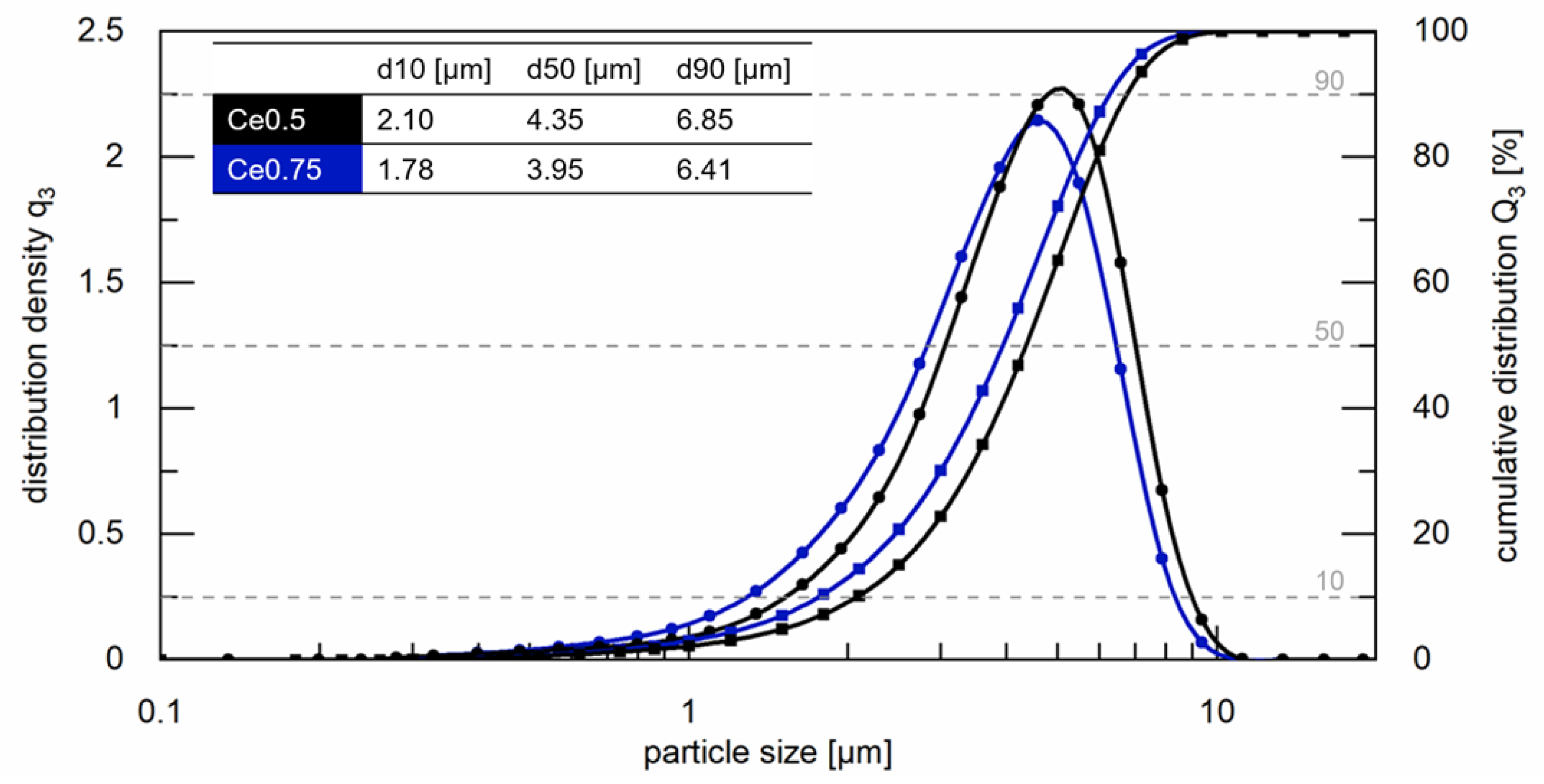

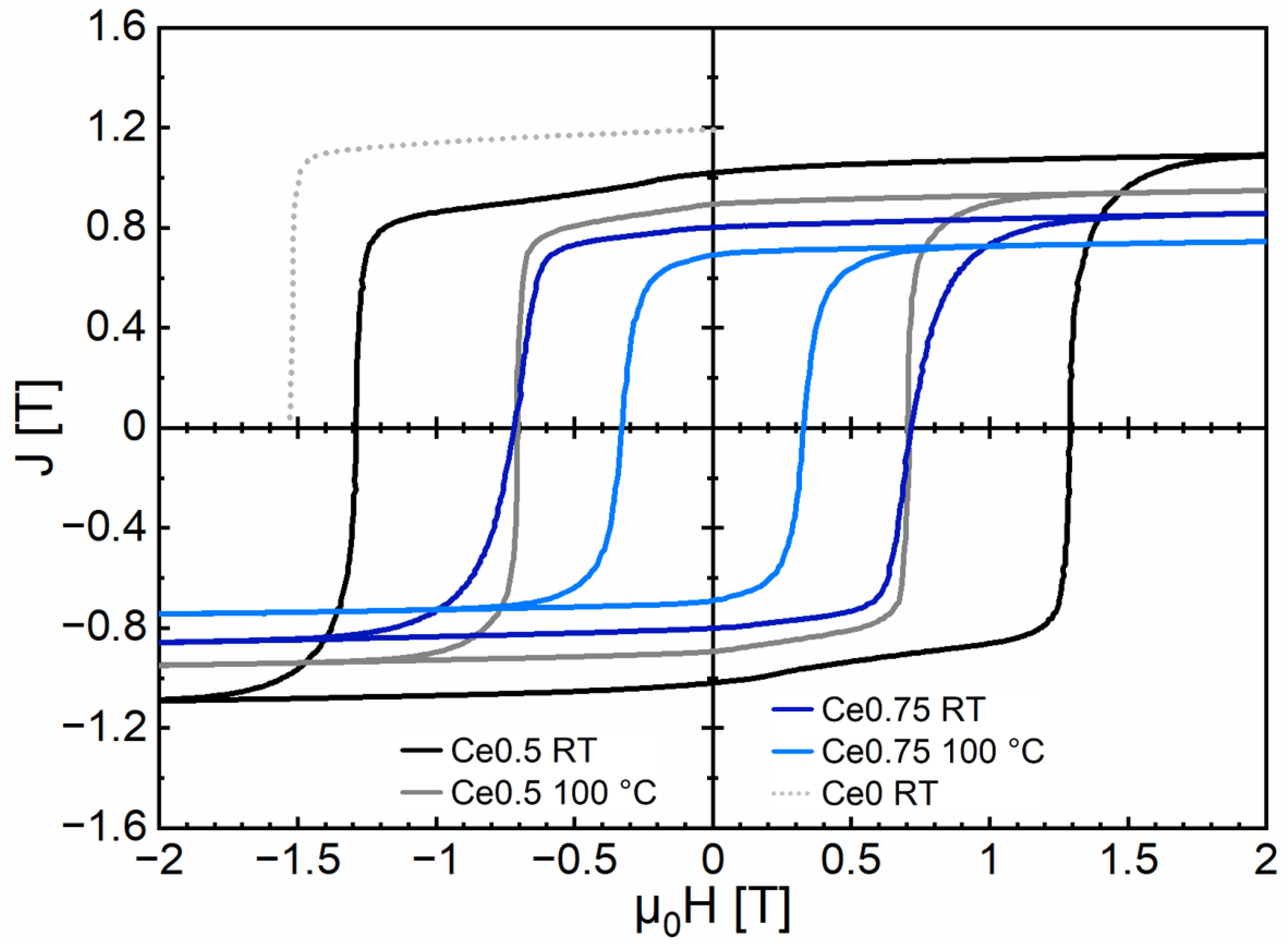

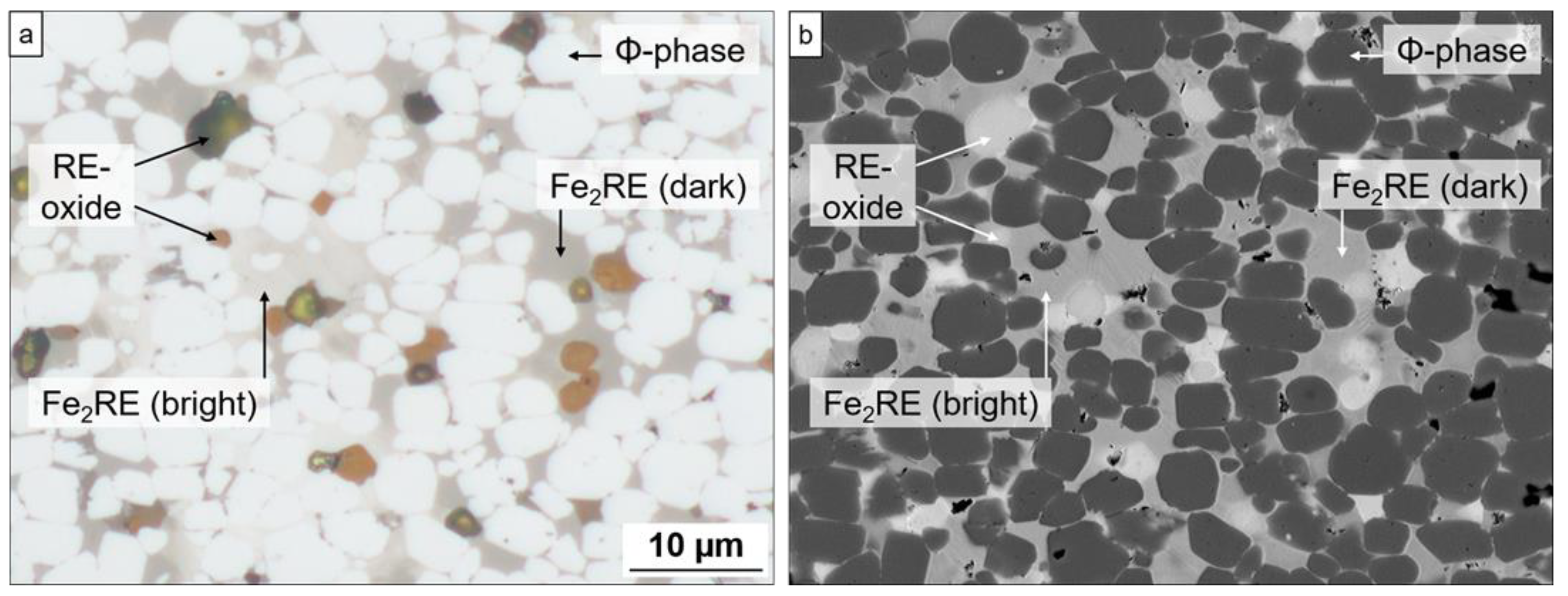
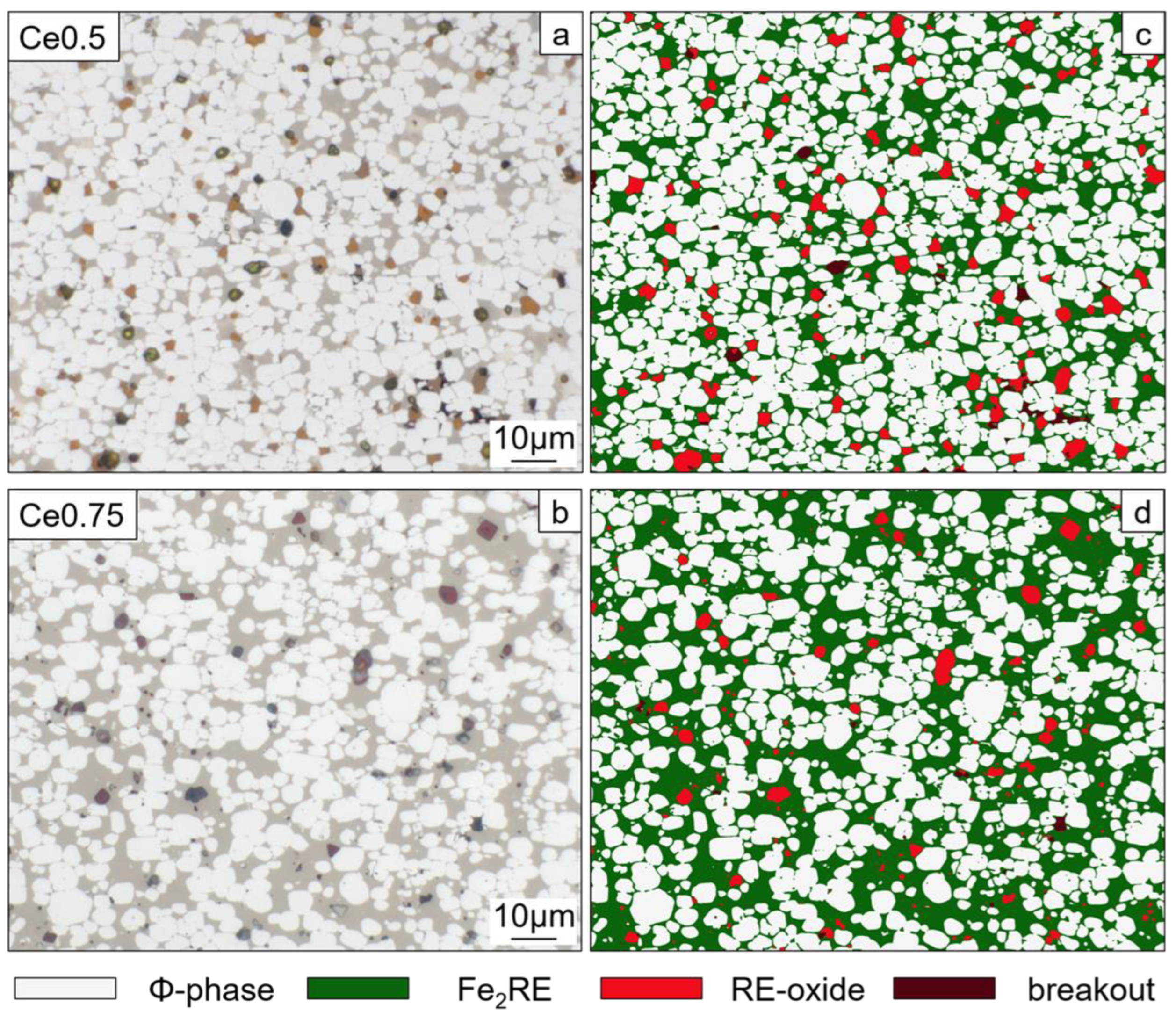

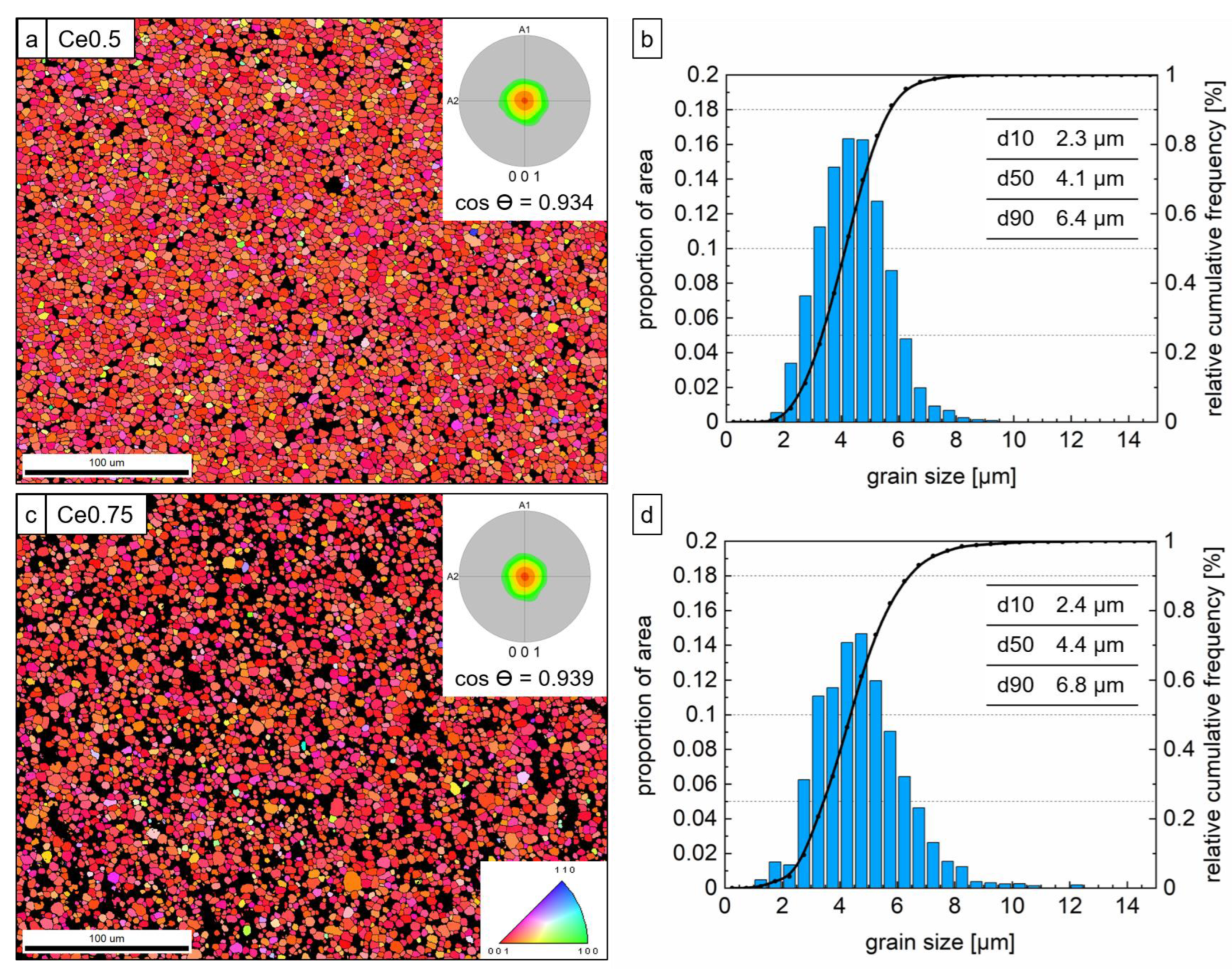

| Sample | T (°C) | Hc (kA/m) | µ0Hc (T) | Jr (T) | (BH)max (kJ/m3) | α | β | TC (°C) |
|---|---|---|---|---|---|---|---|---|
| Ce0.5 | RT 100 | 1026 561 | 1.29 0.70 | 1.02 0.89 | 176.5 136.9 | 0.15 | 0.57 | 286 |
| Ce0.75 | RT 100 | 573 261 | 0.72 0.33 | 0.80 0.69 | 114.5 65.0 | 0.17 | 0.68 | 244 |
| Sample | RE-Element | Composition (at%) | Proportion (%) | ||||
|---|---|---|---|---|---|---|---|
| Alloy (Weigh-In) | 14:2:1 | Fe2RE | Alloy (Baseline) | 14:2:1 | Fe2RE | ||
| Ce0.5 | Nd | 9.4 | 7.4 | 6.3 | 50.0 | 57.8 (+7.8) | 18.7 (−31.3) |
| Ce | 9.4 | 5.4 | 27.3 | 50.0 | 42.2 (−7.8) | 81.3 (+31.3) | |
| Ce0.75 | Nd | 4.7 | 4.2 | 3.2 | 25.0 | 33.3 (+8.3) | 9.3 (−15.7) |
| Ce | 14.1 | 8.4 | 31.2 | 75.0 | 66.7 (−8.3) | 90.7 (+15.7) | |
| Chemical Composition | RE (at%) | Ce (%) | Hc (kA/m) | µ0Hc (T) | Jr (T) | (BH)max (kJ/m3) | Ref. |
|---|---|---|---|---|---|---|---|
| Sintered magnets | |||||||
| Commercial (supplier ChenYang) | 15 | 35 | 1008 | 1.27 | 1.20 | 252 | - |
| (Pr,Nd)8.4Ce5.8Fe78.4M1.4B6.1 | 14.2 | 40 | 660 | 0.83 | 1.25 | 291 | [44] |
| (Pr,Nd)7.6Ce6.4FebalM1.0B6.0 | 14 | 45 | 716 | 0.90 | 1.24 | 292 | [26] |
| (Pr,Nd)7.6Ce6.4FebalM1.0B6.0 | 14 | 45 | 724 | 0.91 | 1.21 | 268 | [34] |
| (Ce,La,Nd)18.8Fe70.9B5.8M4.5 | 18.8 | 75 | 446 | 0.56 | 0.91 | 140 | [37] |
| Ce15.5Nd2.6Fe75.5Al0.1Cu0.3B6 | 18.1 | 86 | 143 | 0.18 | 0.91 | 86 | [35] |
| Ce13.0(Ho,Gd)2.9Fe75.0B7.0MbalCu0.23 | 15.9 | 82 | 133 | 0.17 | 0.80 | 73 | [36] |
| Rapidly quenched magnets | |||||||
| Nd6.89Ce7.10Fe79.98B6.03 (o.stoich.) | 14 | 51 | 915 | 1.15 | 0.66 | 73 | [45] |
| (Nd0.5Ce0.5)2Fe14B (stoich.) | 11.76 | 50 | 493 | 0.62 | 0.73 | 65 | [46] |
| (Nd0.3Ce0.7)2Fe14B (stoich.) | 11.76 | 70 | 318 | 0.40 | 0.69 | 41 | [46] |
Disclaimer/Publisher’s Note: The statements, opinions and data contained in all publications are solely those of the individual author(s) and contributor(s) and not of MDPI and/or the editor(s). MDPI and/or the editor(s) disclaim responsibility for any injury to people or property resulting from any ideas, methods, instructions or products referred to in the content. |
© 2024 by the authors. Licensee MDPI, Basel, Switzerland. This article is an open access article distributed under the terms and conditions of the Creative Commons Attribution (CC BY) license (https://creativecommons.org/licenses/by/4.0/).
Share and Cite
Goll, D.; Loeffler, R.; Boettle, M.; Buschbeck, J.; Schneider, G. Exploring Sintered Fe-(Ce, Nd)-B with High Degree of Cerium Substitution as Potential Gap Magnet. Materials 2024, 17, 3110. https://doi.org/10.3390/ma17133110
Goll D, Loeffler R, Boettle M, Buschbeck J, Schneider G. Exploring Sintered Fe-(Ce, Nd)-B with High Degree of Cerium Substitution as Potential Gap Magnet. Materials. 2024; 17(13):3110. https://doi.org/10.3390/ma17133110
Chicago/Turabian StyleGoll, Dagmar, Ralf Loeffler, Marius Boettle, Joerg Buschbeck, and Gerhard Schneider. 2024. "Exploring Sintered Fe-(Ce, Nd)-B with High Degree of Cerium Substitution as Potential Gap Magnet" Materials 17, no. 13: 3110. https://doi.org/10.3390/ma17133110
APA StyleGoll, D., Loeffler, R., Boettle, M., Buschbeck, J., & Schneider, G. (2024). Exploring Sintered Fe-(Ce, Nd)-B with High Degree of Cerium Substitution as Potential Gap Magnet. Materials, 17(13), 3110. https://doi.org/10.3390/ma17133110




